
Few games in recent years have generated quite as much buzz as the Halo series. The first two games were critically acclaimed by the gaming press, and combined they have sold over thirteen million copies worldwide 1. That's a lot of sales, so Bungie must be doing something right.
With Halo 3 just around the corner, it seems appropriate to take a look at the game that started it all.
As with other entries in the Game Design Lessons series, this article is split into three different sections:
Before I start, I should warn you that this article contains spoilers about the plot. If you haven't played Halo before and don't want the story spoilt, you should bookmark this and read it another time ;)
What's good
A well paced story and gameplay
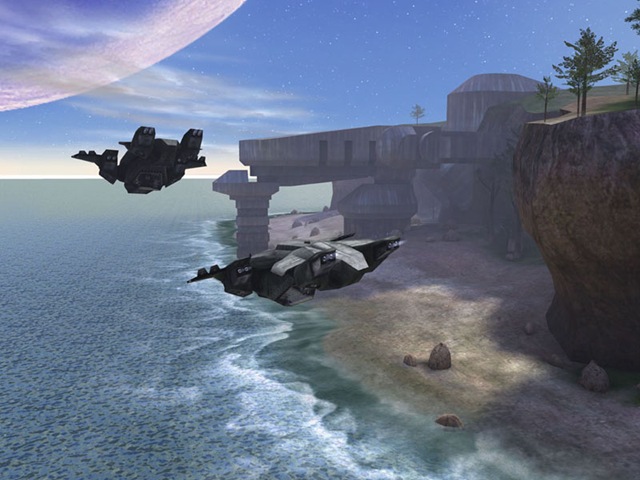
Whatever your opinion of the story's quality may be, it's still fair to say that Halo managed to deliver it at a well balanced pace. Details are revealed at the right speed to keep the player's interest, and there are a few twists and turns along the way.
There are still plenty of "hands off" cutscenes, but there are also set-pieces that the player will encounter whilst playing, such as the Covenant boarding the Pillar of Autumn or the appearance of a certain parasite.
Gameplay wise, the first level takes player's through all the basic controls without putting them in any real danger. By the time the action heats up, all of the fundamentals such as melee attacks and grenade throwing have been introduced. There are are a few "press button X" messages on the screen, but for the most part this introductory tutorial is unobtrusive. This is A Good Thing.
Difficulty levels that are fun AND challenging
The simplest way to make a game harder is to either make the player weaker, or to make the enemies stronger. A complex method is to make the AI characters smarter, so that they're able to make better decisions when attacking.
Halo took the latter approach, and although the enemies on tougher levels have increased health, they also display more complex AI patterns. Grunts will throw more grenades, Elites will seek better cover and Jackels will take down your shields more often. It makes the game much harder, but not in a frustrating way. It's never fun to be beaten by computer opponents, but it's not so bad when you feel it deserved to beat you.
Limited choice
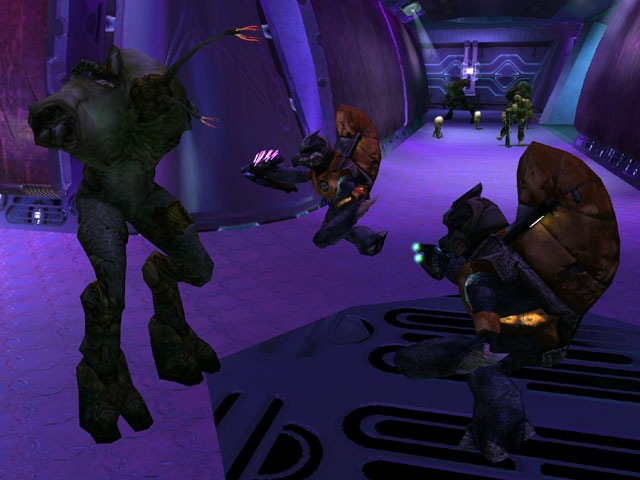
It seems odd to mention limited choice as A Good Thing. It's a risky move that doesn't always work, but when it does it can add an extra layer to the game.
In Halo there are seven weapons and two grenades. Not only is this quite a small arsenal for an FPS, but you're only allowed to carry two weapons at a time. On paper this sounds like a horrible, horrible idea, but in practice it works quite well. Choosing the correct weapons for any situation becomes more important, and power weapons almost seem more powerful because you have to choose whether to sacrifice your weapon slot for them. Things get even more interesting at higher difficulty levels as ammunition becomes hard to come by and every dropped weapon counts.
The same lack of choice works for the enemies, too. The Covenant forces are made of Grunts, Elites, Jackels and Hunters. That's it. What makes this interesting is the way these different races interact when fighting. Grunts will hang around with Elites, so stick a grenade to the big guy and you'll either wipe out the whole squad or send the Grunts scurrying away.
The Flood
The Flood are introduced midway through the game, via a series of atmospheric cut-scenes shot from the perspective of a rather unfortunate marine. This sets the mood for rest of the level, which can be summed up as "we didn't want to do that".
Although they're effectively space zombies (space + zombies = awesome), the dynamic of the game changes once they appear. Tactics that would take down a squad of Covenant are rendered useless against enemies that will quite happily fight with half their face missing. Eventually you end up fighting Flood, Covenant and Sentinels at the same time, and the choice over weapons and tactic becomes vital to your survival.
It concentrates on the fun
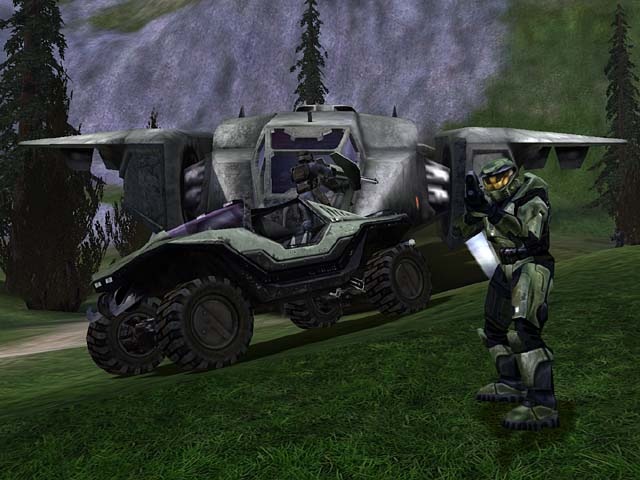
Jamie Griesemer, Halo 2's design lead, is quoted as saying that Halo has thirty seconds of fun 2. It might seem like a negative observation, but it's an important observation. Considering the size of modern games, distilling the core elements into something so simple can help a lot with design. If you know what your players want to do, you can make sure they get plenty of chances to do it.
What's not so good
Repetitious levels
The last few levels of the game take place in the same locations from the first half of the game. In some respects this approach works, as revisiting the old places with new enemies and strategies is fun, but at the same time trudging through the same levels isn't quite as exciting as exploring new places.
Corridors
Once you've had a taste of speeding o'er hills and vales on a Warthog, it's a little disappointing to be stuck back in a typical FPS corridor level. Although it helps to mix up the game a little, a little more diversity in the surroundings would have been nice. Both the Forerunner and Covenant structures are repetitious and visually quite sterile, which makes navigation quite difficult.
Inconsistent checkpoints
There's nothing more frustrating than beating a particularly difficult part of a level, only to die and and have to repeat it. The checkpoint system in Halo solves this problem some of the time, but not always. Sometimes checkpoints aren't saved for some time, and you'll end up repeating huge parts of a level.
The Library
If there's one level of the game that sums up all of these problems, it's "The Library". The level design is repetitious, the scenery is somewhat dull and difficult to navigate and checkpoints will often fail, meaning you'll have to do that really tough bit all over again.
What can be learnt
Getting beaten is fine
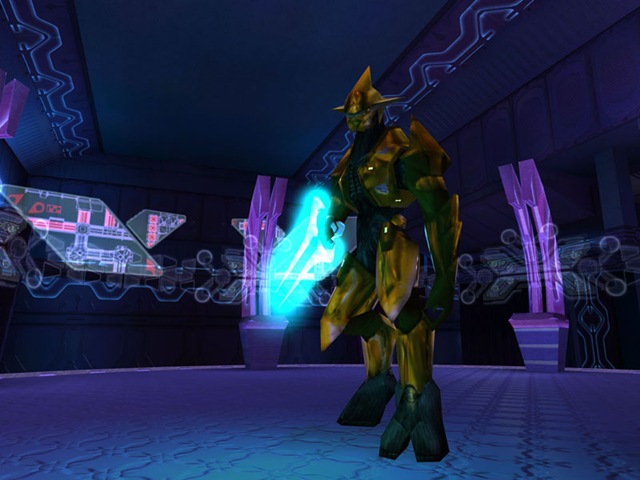
Nobody plays games to lose, but winning all the time isn't much fun either. Victory is always more rewarding when you feel that you overcame the odds to achieve it.
Finding the right balance of difficulty and fun is a challenge, especially when you have to cater for all abilities. Remember, some of your players may never have played anything else before, so don't expect them to have any idea of what they're doing. On the flip-side, some people may have played a million other games before, so they won't want to sit through a 2 hour tutorial.
If you're going to offer different difficulty levels, think about doing more than just changing time limits and health meters. It takes more work, but advanced players will appreciate the extra challenge.
You don't need a million choices
Starting a new game design can be a daunting experience, especially as every "triple A" game is usually touted as revolutionising the way we play. What's important is to give the player choice.
For example, only being able to carry two weapons sounds like a bad idea, but what it actually does is let players choose from a combination. This added layer of choice makes encounters more interesting. After all, if you can always carry a rocket launcher, why worry about what you'll use to clear the next area?
You're allowed to promote your game
Microsoft has a lot riding on the success of the Halo series, and it shows in the way they advertise the game. Now I realise indies don't exactly have the same budget as MS, but there are plenty of other ways to advertise your games.
It could even be argued that indie developers have more options available as they don't have to worry about the restrictions faced by larger companies, such as keeping a corporate image or trying to look cool and failing miserably. Social sites like MySpace, Facebook and YouTube have given independent developers a whole new platform for spreading the word and creating a community of fans.
Remember: don't be ashamed to promote your game. Marketing can sometimes feel "dirty", but if you truly believe your game is entertaining and worth playing, then it is worth taking the time and effort to promote it.
Put your heart into it
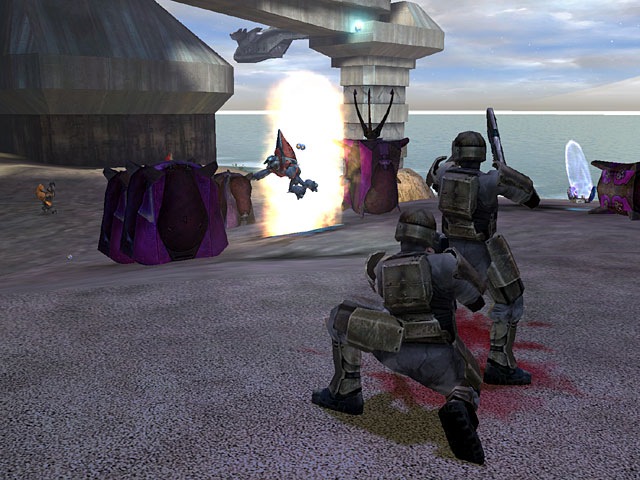
Whatever your opinion of the Halo series, there can be little doubt that the Bungie team really care about their games.
When you're making a game, it can feel like you have to have a certain image in order to be accepted. Keeping your game sterile will only hurt it in the long term. Fans don't tell their friends about games that have "this awesome 16.7 million colour palette and 10,000 polygon models". They tell them about awesome it was when they drove a Warthog off a cliff onto a group of Jackels , or how funny it was when a grunt shouted "not again" after being stuck with a plasma grenade.
Don't sanitise your ideas because you think they won't appeal to the masses. The personality you give your games can become their strongest selling point.
Find the fun and stick to it
It's tempting to keep adding features to games so that you can add more bullet points to your sales pitch. All you really need to do is find the fun parts and make more of them. This doesn't mean you should repeat the same bits over and over, but don't be afraid to use the same elements in different situations.
A good example of this is the turtles in Mario - it's fun to jump on them, but a whole game of turtle jumping probably wouldn't be much fun. To make things more interesting, they're placed in different situations. Sometimes they fly, so you need to jump on them to avoid falling to Certain Death, whereas other times you need to jump on them to clear a line of enemies blocking the way.
Find out what parts of your game design are fun, and make sure the player gets plenty of chances to experience this fun.
That's all for now
Halo is not a perfect game by any means (I'm yet to play one), but there are still many lessons to learn from its design and storytelling. Being an independent developer is exciting and liberating, and whilst we may not have the same resources at our disposal as larger development houses, we can still learn from their successes and failures to make our games even better.
Footnotes:
According to WikiPedia, Halo:Combat Evolved has sold over five million copies and Halo 2 has sold over eight million copies worldwide.
This was originally said in a documentary packaged with the Halo 2 Collector's Edition. There's an interview with members of the Bungie staff, including Jamie, at Edge Online.
1 Comment
One point I think you may have missed - Halo doesnt have a 'game over' screen - you just automatically restart from the last checkpoint, so the 'press A to continue'\you're dead screen doesnt get in the way of the game.